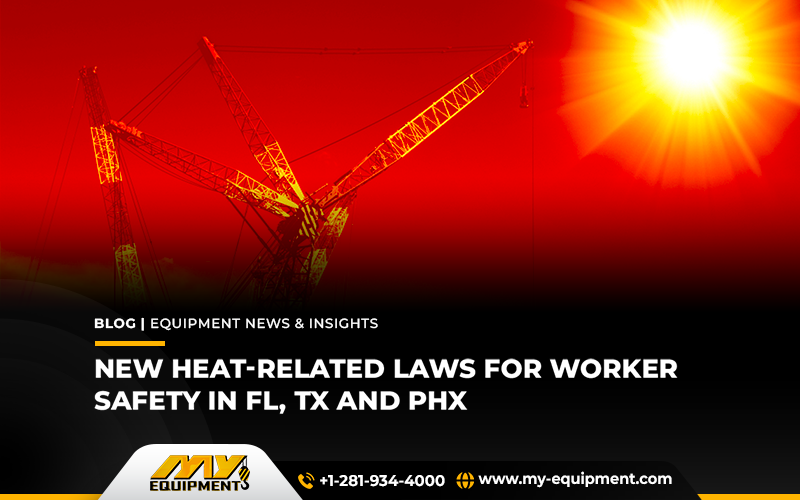In a recent report, Florida workers raised concerns about the violation of their basic rights at the construction job sites. They were not allowed to access the water, rest and shade breaks during construction jobs on a scorching hot day. This issue was brought to the attention of the higher authorities, leading to immediate action plans and the passing of laws for worker’s safety.
Extreme heat is a kind of major concern for outdoor workers as summer is at its peak, particularly in places like Texas, Florida, and Arizona. Anyhow the risks and discussions on how to strike a balance between worker safety and regulatory uniformity have been urged by recent legislative developments in these states.
How can severe heat increase the health risks for workers?
As soon as Memorial Day hits the signal of starting summer days, the construction contractors gear up to boost their construction project work length. This is because they can now take advantage of longer daylight. But workers, particularly in southern areas, face significant health hazards as a result of the increased heat. According to recent NASA statistics, the summer of last year was the hottest in 2,000 years, surpassing records in places like Miami and El Paso. These circumstances are a clear indication of how urgently outdoor workers need to implement efficient heat safety measures.
What changes were made to Texas and Florida Laws?
Amid the rising protests, new legislation has been presented in Texas and Florida to stop local governments from requiring water breaks for employees. House Bill 433, which was signed into law by Governor Ron DeSantis, forbids counties and localities in Florida from establishing their own heat safety laws beginning in July. Likewise, Texas endorsed a contentious statute known as “The Death Star Bill,” which is presently being challenged in court by cities such as Houston and San Antonio.
These laws prohibit local ordinances that call for breaks even for the operators of used heavy equipment in Texas, but they do not prohibit employers from offering them. Advocates argue that a combined state-wide strategy avoids regulatory disparities, which may pose difficulties for businesses with operations in several states. Critics, such as the American Civil Liberties Union, oppose that these rules eliminate necessary protections and could jeopardize the health of workers.
Phoenix’s Take on to this Initiative
Phoenix has taken proactive measures to protect employees from intense heat, in contrast to the strategies used in Texas and Florida. An ordinance mandating thorough heat safety plans for businesses working on city contracts was passed by the Phoenix City Council in March. This strategy has to contain:
- Free chilly drinking water is available
- Frequent and essential pauses during long working hours
- Air conditioning or access to shade for indoor or outdoor tasks
- Practices for accommodation
- Instruction on heat-related illnesses and injuries
Federal Actions and OSHA’s Contribution
The Occupational Safety and Health Administration (OSHA) is now seriously creating a heat safety standard at the federal level. OSHA lacks a clear regulation for shielding employees from the heat, despite having defined guidelines for a number of different risks. With Doug Parker, the director of OSHA, highlighting the importance of the rulemaking process, the agency successfully overcame a major obstacle in April.
The current OSHA strategy includes a nationwide emphasis program designed to inform employers about the three main ways to mitigate high heat:
- Staying hydrated,
- Getting rest, and
- Finding shade
While the Occupational Safety and Health Act of 1970’s general obligations section serves as the primary basis for enforcement, OSHA collaborates with business executives to promote a safety-first mentality.
Optimal Procedures for Heat Safety
Although there are no national rules in place, many contractors follow common sense procedures to protect their employees. OSHA, however, offers the following suggestions to help avoid illnesses brought on by the heat:
Acclimatization
During the first several days of hot weather, schedule shorter shifts with more frequent breaks to gradually increase the amount of time that employees are exposed to the heat.
Instruction
Inform employees on the signs and symptoms of heat stress as well as ways to avoid it.
Hydration
Regardless of thirst, remind employees to consume one cup of chilled water every 20 minutes.
Clothes
To aid in heat dissipation, encourage wearing light, breathable clothing.
Monitoring
Establish a buddy system and examine employees frequently for symptoms of heat exhaustion.
Breaks
To avoid overheating, make sure you allow the workers to take regular breaks in air-conditioned or shaded areas.


 1400 Broadfield Blvd, Houston, TX 77084,
USA.
1400 Broadfield Blvd, Houston, TX 77084,
USA.